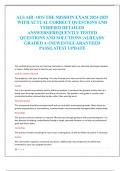ALS AIR -101S THE MISSION EXAM 2024-2025
WITH ACTUAL CORRECT QUESTIONS AND
VERIFIED DETAILED
ANSWERS|FREQUENTLY TESTED
QUESTIONS AND SOLUTIONS |ALREADY
GRADED A+|NEWEST|GUARANTEED
PASS|LATEST UPDATE
This method discusses how our listening motivation is crippled when we adversely stereotype speakers
or topics. Relate the topic at hand to your own interests.
Look for common Ground
This property is the spice of speaking. You may fluctuate your voice and at the same time improve the
communication by considering the vocal fundamentals of rate, volume, force, pitch, and emphasis.
Variety
This is the method most widely used by effective speakers. It produces the greatest results when it is
based upon thorough preparation and plenty of practice. The speaker's only guide is usually a well-
constructed outline, planned idea by idea rather than word by word.
Extemporaneous
This component should be consistent with and not contradict accompanying words. When these are
grossly inappropriate or contradictory, communication can permanently damage healthy relationships.
Nonverbals
This process works to maintain or improve effectiveness through guidance and recommendations. It is
also directed at helping a subordinate through a tough, personal situation, or to help set professional
goals and future plans
Counseling
This process includes recording the root cause, creating plans, as well as follow-up actions if necessary.
Session
This commander organizes commands and forces. Additionally, they employ forces within that
command to carry out assigned missions.
1|Page
,Combatant commander
In a rush to leave at the end of shift, SrA Price e-mailed his supervisor, instead of speaking to him face-
to-face, to ask a work-related question, then he went home. The next day his supervisor asks him "Why
didn't you ask me before you left shift yesterday?"
Consider whether e-mail is the best choice
SrA Ball saw something that she thought was amusing and wanted to post it to her social media account.
However, she wasn't sure if it was offensive to others, so she decided not to post it.
Respect yourself, others, and the Air Force with what you post
When you listen to understand and help others in situations where emotions and the speaker are
involved, not just the message.
Empathetic Listening
A valuable communication skill and critical to good communications, but one that gets little respect and
attention.
Listening
This type of information substantiates a position.
Support
The process of sharing ideas, information, and messages with others. In the Air Force, most of this
involves speaking and writing, but this definition also includes nonverbals, such as body language,
graphics, electronic messages, etc.
Communication
Carefully reading the words or really listening to the speaker for the real message.
Focus
When you listen to collect information from others.
Informative Listening
Material being presented in a logical, systematic manner.
Organized
This category of barriers includes physical fatigue, illness, and discomfort, as well as psychological
distractions such as work, family, or financial problems, and can affect listening.
personal
When the speaker's intent may not be understood by the audience when using words or phrases with
more than one meaning; ideas, objects, or actions with more than one word image; or slang, jargon or
organizational acronyms.
2|Page
, Semantic Barriers
Examples include noisy equipment, visual distractions, etc. that block listening motivation.
Physical Barriers
When you listen to judge, to evaluate a situation, and make decisions.
Critical Listening
The act of exercising careful judgment in forming opinions or conclusions.
Critical Thinking
One of the most important factors of nonverbal communication.
Eye Contact*
The poorest method of delivering talks; should be used very sparingly or not at all.
Memorizing
A communication style where information flows only one way.
One-Way Communication
A relationship with open, honest communication focused on problem-solving and subordinate-led
solutions.
Helping Relationship
Obstacles to effective communication, divided into two basic types: organizational and psychological.
Examples include environmental noise, weak communication policies/norms, autocratic management,
personality, values, and language.
Barriers
A face to face, one way, or multi-directional exchange of verbal messages and nonverbal signals
between two or more people for the purpose of gaining a shared meaning.
Interpersonal Communication
Body language
sends messages through body posture (slouching, sitting erectly, lounging, crossed arms, etc.) and
behaviors (stomping a foot, pointing a finger, shaking the head, etc.).
Eye contact
happens when the sender and receiver are looking into each other's eyes.
Facial expressions
show expressions of fear, surprise, joy, sadness, anger, disgust, etc., conveyed through brow, eye, and
mouth configurations.
3|Page




